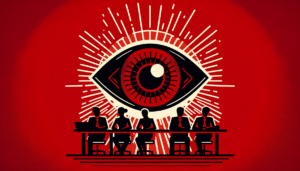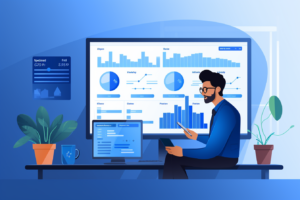Dave Ulrich: How human capability creates value for all stakeholders
- 8 Min Read
HR thought leader Dave Ulrich shares his recent research with The Conference Board on delivering stakeholder value through investments in human capability.
- Author: Dave Ulrich
- Date published: Dec 19, 2022
- Categories

In an age of increased calls for transparency, a rise in regulatory disclosure mandates and a general recognition of a corporation’s need to address the concerns of a wide variety of stakeholders, the ability to understand human capability and its ability to drive business results has never been greater. However, many efforts to articulate stakeholder value through human capability are isolated and piecemeal, using perceptual (interview or survey) data to prepare reports about which initiatives to focus on. There is often little analysis of which HR metrics deliver the most business value.
Dave Ulrich, PhD, Rensis Likert Professor, Ross School of Business, The University of Michigan, proposes a set of guidelines or blueprint he calls the Human Capability Framework. This framework helps boards, CEOs, C-suite executives, and other stakeholders make informed choices about which people-related initiatives drive key outcomes, where to prioritize the work of the HR function, and how to better prepare for regulatory disclosures and reporting that can improve business outcomes and build confidence in the organization’s future.
The framework has been tested and validated using the latest machine learning/AI technologies in partnership with Amazon Web Services with data from the SEC disclosures of 7,000+ companies.
To listen to the webcast Human Capability and Company Performance, go here.
Insights for what’s ahead
To help investors, boards, executives, and HR leaders clarify how to think about people and organization issues, the Human Capability Framework focuses on four pathways to improve decision-making: talent + leadership + organization + the HR function. By clustering multiple insights into the four human capability pathways, an HR or business leader may make progress by focusing attention on which of the four pathways best delivers desired results.
Figure 1: Six Actions, Questions, and Next Steps to Create Stakeholder Value from Human Capability
![]()
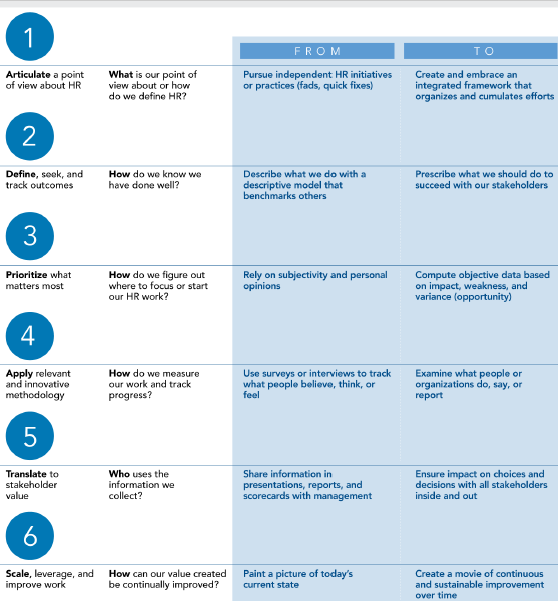
What human capability means
We propose a simple and integrated framework for people and organization called the Human Capability Framework,1 which includes four pathways: talent + leadership + organization + HR function.
- Human refers to talent (human capital, employee, workforce, people, competence).
- Capability refers to organization (team, workforce, capability).
- Leadership bridges the two and refers to both individual leaders and to collective leadership.
- HR function refers to the HR department, practices, and people.
This Human Capability Framework clarifies and evolves how to think about and treat people and organization issues. Figure 2 demonstrates an evolution that the management of people has moved from an administrative / operational focus (personnel) to an array of people practices (human resources) to delivering talent (human capital) to human capability (focused on delivering value to all stakeholders through the four pathways constituting human capability).
Innumerable innovations proliferate in each of these four pathways (see Figure 3 for 37 initiatives across the four pathways). Having a way to integrate these initiatives allows organizations to progress in ways that build rather than having isolated and often repackaged initiatives. A standard human capability framework is a crucial step to being able to compare people and organization initiatives across companies and industries.
These four human capability pathways are like the generally accepted accounting principles (GAAP) that shape financial decisions and reporting, the four food groups for nutrition, and the big five personality traits that are the basis of psychometric personality assessments. Without a standard human capability framework, organizations work independently, and stakeholders cannot compare investments or value creation.
We believe this “framing” of loosely defined and often disconnected HR initiatives into the human capability framework can become the foundation for a standard framework for the field. In any business discussion related to people and organization, these four pathways can be the basis for dialogue (do we have the right talent, leadership, organization, and HR to deliver stakeholder value?), investment (where do we invest in the four pathways to make progress?), and disclosure (how do we communicate our human capability efforts?).
Figure 2: Evolution of HR Field to Human Capability
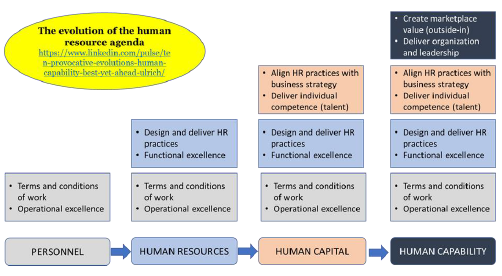
Figure 3: Thirty-Seven Initiatives in Four Human Capability Pathways
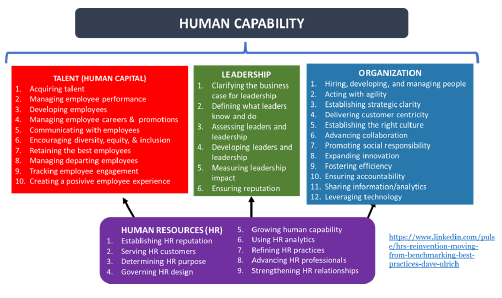
Figure 4: Why Human Capability Matters
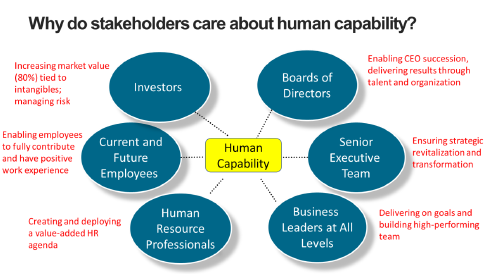
How to measure human capability
The prevalent methodology to determine how to create human capability value is to ask respondents their opinions through interviews or surveys, then analyze the responses to see patterns. People’s opinions, collected through interviews or surveys, are relevant, but more accurate data can be collected by identifying what people do.
Surveys collect information but have response bias, limited information sourcing, and multicollinearity (everything is interdependent) findings. For research on human capability to lead to actionable insights, information can be sourced with machine learning, AI, and natural language processing (NLP) tools, which moves beyond traditional surveys. For example, I may perceive and report that I am eating healthy, but if someone tracks what I actually consume, my perception, though well intended, could be inaccurate.
In partnership with Amazon Web Services AI experts, we were able to use machine learning and NLP to score 7,000 organizations on the extent to which they disclosed efforts in their public reporting in each of the four pathways. For 5,700 of these firms, we were able to run predictive analytics about human capability overall as well as in each of the four pathways as they affected employee, financial, and social reputation outcomes.
Our findings using this methodology are remarkable and have double the impact of previous studies using survey methodology. Human capability scores explain:
- 44 percent of employee productivity;
- 26 percent of cash flow (earnings before interest, taxes, depreciation, and amortization);
- 25 percent of market value over intrinsic value or intangibles (Tobin’s Q); and
- 36 percent and 48 percent of two social responsibility indicators.
These results are nearly double the industry average for impact of Human Capability on these results as measured by surveys. This validates the reliability of our Human Capability Framework and the machine learning / AI methodology for explaining results. Each of the stakeholders in Figure 4 who rely on human capability to help them reach their goals should access this information to make more informed human capability investments.
How to improve human capability investments
Improving human capability investments and assessment of those investments has implications for both business and HR leaders.
Implications for business leaders (board, senior executives, and all managers)
Using the Human Capability Framework, business leaders have a consistent way to focus on human capability to deliver value to all stakeholders. The work enables leaders to know how their human capability investments compare to others.
Figure 5: Company Profile on Human Capability Based on Disclosures
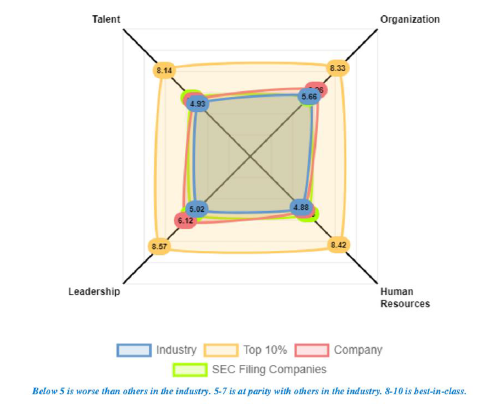
With this information, leaders can then identify which human capability investments to pursue to deliver stakeholder value with a three-step decision process:
- Impact Focus on human capability initiatives that have the most impact on desired stakeholder outcomes.
- Weakness Focus on human capability initiatives that overcome weakness (get to parity with others) and demonstrate unique strengths (be the best in targeted initiatives).
- Opportunity Focus on human capability initiatives where there are opportunities to differentiate from others.
Once the human capability priorities are targeted, leaders can access and pursue actionable insights to make improvements. As improvements occur, leaders can intentionally disclose their human capability efforts to deliver value to all stakeholders.
Implications for C-suite executives
With this research, the broadly defined HR function has a framework that allows for innovation (lots of new ideas and initiatives), integration (organizing individual initiatives into the four pathways), and impact (prioritizing which pathway and which specific initiatives deliver the most value to stakeholders). The Human Capability Framework leads to improvements in talent, leadership, organization, and HR that enable any business growth strategy (product innovation, customer service, or geographic expansion). The Human Capability Framework enables ESG ambitions to be realized by bringing discipline to the “social” elements of an ESG agenda and by clarifying the talent, leadership, organization, and HR initiatives that will sustain ESG efforts. HR professionals who become architects, facilitators, and coaches of human capability partner in delivering stakeholder value.
How to disclose human capability
The early, and vague, regulatory mandate for reporting human capital can and should evolve to provide more accurate information that will help all stakeholders. Currently, this human capital reporting often shows up as advocates encouraging the reporting of specific data consistent with their interests (e.g., number of days of training, CEO to average worker pay ratios, diversity numbers, time to hire, safety figures). There is little analysis of which of all the possible metrics delivers the most value to key stakeholders, nor are metrics bundled into an integrated human capital framework that enables consistent monitoring of how human capital delivers stakeholder value.
As human capability disclosures advance, business and HR leaders can be more focused about what they report to give stakeholders confidence in their future, what specific human capability initiatives drive key outcomes, and where to prioritize the initiatives that make the most impact.
To create sustainable stakeholder value, these efforts should be combined into an overall human capability agenda using the Human Capability Framework. This agenda includes prioritizing four pathways as well as the initiatives within each pathway based on how they affect the stakeholders in Figure 4. This ongoing human capability agenda must be monitored and tracked over time by assessing required annual disclosures, then improving on priority areas.
________________
To learn more, visit the G3 Human Capability website.
Dave Ulrich, PhD
Rensis Likert Professor, Ross School of Business, The University of Michigan
Co-founder and Principal, The RBL Group
Human Capital Center Advisor, The Conference Board
Rebecca L. Ray, PhD
Executive Vice President, Human Capital
The Conference Board


